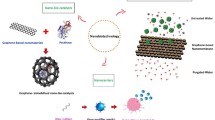Abstract
A bottom-up approach based on a solvent displacement technique was used for the production of α-tocopherol nanodispersions. Response surface methodology was utilized to study the effect of the mixing conditions of organic and aqueous phases, namely, mixing speed (1 × 100–6 × 100 rpm) and mixing time (30–150 s) on the average particle size (nm), polydispersity index and α-tocopherol concentration (mg/L) of the nanodispersions. Second order regression models, with high coefficient of determination values (R 2 > 0.94 and adjusted R 2 > 0.79), were significantly (p < 0.05) fitted for predicting the α-tocopherol nanodispersion characteristics as functions of mixing parameters. A multiple optimization procedure presented the optimum mixing speed and time as 3.8 × 100 rpm and 70 s, respectively. The statistically insignificant differences between experimental and predicted values of studied responses, verified the satisfactoriness of the models found for explaining the variation of produced nanodispersions, as a function of mixing conditions.






Similar content being viewed by others
References
de Carvalho SM, Noronha CM, Floriani CL, Lino RC, Rocha G, Bellettini IC, Ogliari PJ et al (2013) Optimization of α-tocopherol loaded solid lipid nanoparticles by central composite design. Ind Crops Prod 49:278–285
Khayata N, Abdelwahed W, Chehna MF, Charcosset C, Fessi H (2012) Preparation of vitamin E loaded nanocapsules by the nanoprecipitation method: from laboratory scale to large scale using a membrane contactor. Int J Pharm 423(2):419–427
Silva HD, Cerqueira MA, Souza BWS, Ribeiro C, Avides MC, Quintas MAC, Coimbra JSR et al (2011) Nanoemulsions of β-carotene using a high-energy emulsification–evaporation technique. J Food Eng 102(2):130–135
Cheong JN, Tan CP, Man YBC, Misran M (2008) α-Tocopherol nanodispersions: preparation, characterization and stability evaluation. J Food Eng 89(2):204–209
Anarjan N, Mirhosseini H, Baharin BS, Tan CP (2010) Effect of processing conditions on physicochemical properties of astaxanthin nanodispersions. Food Chem 123(2):477–483
Yang Y, McClements DJ (2013) Encapsulation of vitamin E in edible emulsions fabricated using a natural surfactant. Food Hydrocoll 30(2):712–720
Ghosh I, Bose S, Vippagunta R, Harmon F (2011) Nanosuspension for improving the bioavailability of a poorly soluble drug and screening of stabilizing agents to inhibit crystal growth. Int J Pharm 409(1–2):260–268
Thorat AA, Dalvi SV (2012) Liquid antisolvent precipitation and stabilization of nanoparticles of poorly water soluble drugs in aqueous suspensions: recent developments and future perspective. Chem Eng J 181–182:1–34
McClements DJ (1999) Food emulsions: principles, practice and techniques. CRC Press, Boca Raton
Anarjan N, Tan CP (2013) Effects of selected polysorbate and sucrose ester emulsifiers on the physicochemical properties of astaxanthin nanodispersions. Molecules 18(1):768–777
Bezerra MA, Santelli RE, Oliveira EP, Villar LS, Escaleir LA (2008) Response surface methodology (RSM) as a tool for optimization in analytical chemistry. Talanta 76:965–977
Montgomery DC (2001) Design and analysis of experiments. Wiley, New york
Gharibzahedi SMT, Mousavi SM, Hamedi M, Khodaiyan F, Razavi SH (2012) Development of an optimal formulation for oxidative stability of walnut-beverage emulsions based on gum arabic and xanthan gum using response surface methodology. Carbohydr Polym 87(2):1611–1619
Anarjan N, Mirhosseini H, Baharin BS, Tan CP (2011) Effect of processing conditions on physicochemical properties of sodium caseinate-stabilized astaxanthin nanodispersions. LWT Food Sci Technol 44(7):1658–1665
Beck C, Dalvi SV, Dave RN (2010) Controlled liquid antisolvent precipitation using a rapid mixing device. Chem Eng Sci 65(21):5669–5675
Sinha B, Müller RH, Möschwitzer JP (2013) Bottom-up approaches for preparing drug nanocrystals: formulations and factors affecting particle size. Int J Pharm 453(1):126–141
Yuan Y, Gao Y, Mao L, Zhao J (2008) Optimisation of conditions for the preparation of β-carotene nanoemulsions using response surface methodology. Food Chem 107(3):1300–1306
Jafari SM, Assadpoor E, He Y, Bhandari B (2008) Re-coalescence of emulsion droplets during high-energy emulsification. Food Hydrocoll 22(7):1191–1202
Saberi AH, Fang Y, McClements DJ (2013) Fabrication of vitamin E-enriched nanoemulsions: factors affecting particle size using spontaneous emulsification. J Colloid Interface Sci 391(1):95–102
Tan CP, Nakajima M (2005) β-Carotene nanodispersions: preparation, characterization and stability evaluation. Food Chem 92(4):661–671
Acknowledgments
Financial support of this work by INSF (Iran National Science Foundation) through the Science Fund (91002606) is gratefully acknowledged.
Author information
Authors and Affiliations
Corresponding author
About this article
Cite this article
Anarjan, N., Jaberi, N., Yeganeh-Zare, S. et al. Optimization of Mixing Parameters for α-Tocopherol Nanodispersions Prepared Using Solvent Displacement Method. J Am Oil Chem Soc 91, 1397–1405 (2014). https://doi.org/10.1007/s11746-014-2482-6
Received:
Revised:
Accepted:
Published:
Issue Date:
DOI: https://doi.org/10.1007/s11746-014-2482-6




